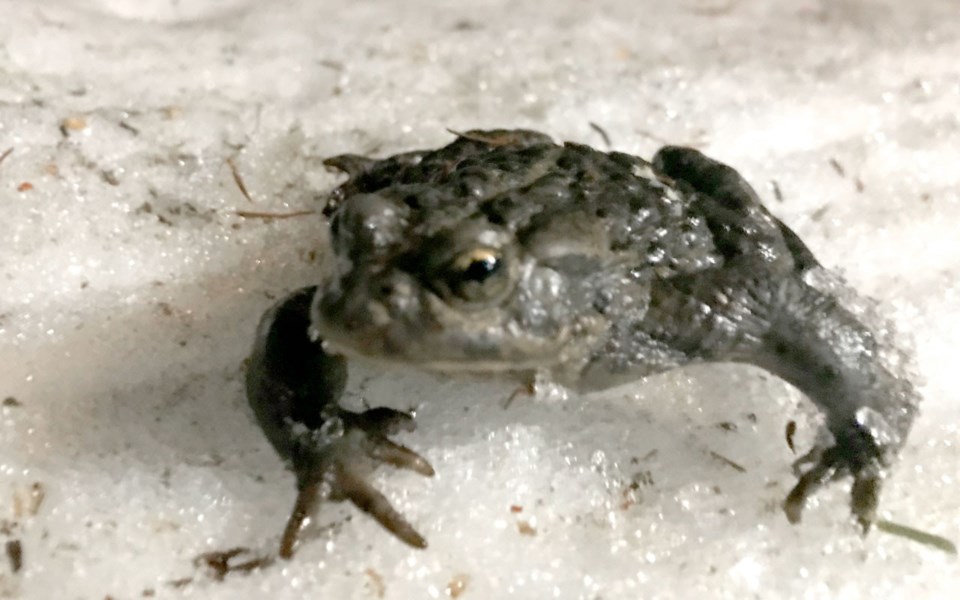The other day, after our first good March rain in the valley, a friend texted me a photo of a Western toad crossing a snowy trail at Lost Lake. When the toads start to move in Whistler, it always reminds me of the time I spent studying such things as a biology graduate student.
My study site was a large beaver pond in Haliburton, Ontario, just south of Algonquin Park. I'd arrive when the late March woods were quiet, sullen, and grey, then spend a month counting amphibians as they made their spring migrations to ancestral breeding areas. Like Lost Lake, thick ice crowning the pond would be barely free of the shore, with water glistening darkly in only a few places along the edge. But each time a warm south wind delivered rain, all hell would break loose.
In most of Canada, springtime means hockey, maple syrup, and a long-awaited respite from the cold. But while humans measure spring's air of renewal in cultural terms, some animals are tied to a more stringent metric: it's the only time of year an individual might see another of its kind. Naturally, such encounters engender a kind of urgency—one that also gets biologists excited.
When it rained, I'd wait until dark then head into the forest. Muffled noise from the leaf litter would meld with the rain and a growing cacophony from the pond—the kind of sounds that could make your skin crawl. But the night was alive and the ground around me moving; no Hollywood special-effects tech could conjure what I tracked in my headlamp.
Blind with purpose, thousands of glistening amphibians rose from the quiescence of the forest floor, zig-zagging towards the pond in drunken clusters, bouncing off each other like surprised billiard balls—burnished Wood Frogs, tiny Spring Peepers, striking Yellow-spotted Salamanders, and glabrous Blue-spotted Salamanders. The sheer numbers were impressive: I could count more within a metre of where I crouched than the average person might see in a lifetime.
The secret world of amphibian breeding involves not only migration, but a prodigious burst of ritual advertisement, frantic courtship and furtive mating—kind of like spring break in Daytona Beach without the booze. I'd watch mesmerized as the animals converged from every direction, swarming over snow, ice, rock and wood, their internal switches firmly locked onto Phase One: Must Get To Water. Put something in front of them, they went over it; put them in something, they climbed out. Water, when it was reached, became a sanctuary for Phase Two: Must Mate. In my light beam, startled frogs leapt into the darkness, while at the pond's edge salamanders seemed to sense the weight of their impending biological destiny; pausing briefly, they appeared to take one last look around before plunging beneath the ice.
I felt privileged to witness so many of these nocturnal scrambles. Not simply because they are deeply fascinating in a biological sense, or that so few people ever see such things, but because so few ever will have a chance to see them: disease, pollution, invasive species, shrinking habitat, road mortality and even climate change have made such spectacles increasingly rare in Canada. Because amphibians are adapted to specific regimens for breeding, larval development, and adulthood, climatic flux acting at any juncture can affect both populations and overall distribution. A warming climate, for instance, will favour a few species but be detrimental to most. Increasingly frequent mid-winter mild spells prompt premature breeding by some species, whose eggs are then destroyed by freezing when weather returns to seasonal norms. At the other extreme, exceptionally hot spring days cause water temperatures to spike, accelerating fungal, algal and bacterial growth that kill eggs—an effect exacerbated when trees that moderate water temperature are cut from the margins of aquatic habitats (e.g., clear cutting).
While human activities and fragmented habitat drive local amphibian extinctions, what happens during natural climatic shifts? Basically, the same thing—changing distributions of species adapted to particular ecological/climatic associations. The difference is that these occur gradually over vast periods of time as part of larger, integrated change to which species can adapt.
But back to the toad at Lost Lake. The photo was like a postcard from the Devonian, when amphibians first evolved. Today, 370 million years later, even superficial understanding of such little-known netherworlds grants awkward membership: after studying them so long, I always felt that were I a frog or salamander in spring, I'd know just where to go and what to do.
Leslie Anthony is a biologist, writer and author of several popular books on environmental science.




